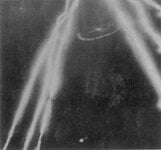The attached image is on the Leigh Light Wiki and is captioned "Photograph of a destroyed U-boat illuminated by Leigh Lights". Initially I took it at face value but the more I looked at it the more uncertain I became. Why would a single source light produce six light streams? (Rocket attack?) The Wiki image was taken from a book called "A Brief History of the Royal Air Force" by C.J. Finn. I have a copy on order and have tried to contact the Wiki contributor. However I found what might be the original source within Coastal Command Review Vol 3 No 10 October 1944. This is captioned "This photo was taken after a night attack off the Norwegian coast on 24 September [1944] by Liberator A/224. The U-boat concerned was probably sunk". No mention of the Leigh Light or any illuminant such as 4" and 1.7" flares. Before it reached the CCR I expect the photo was part of the UBAT after attack report completed by the crew but so far I have not found that. To muddy the waters further the squadron logs at TNA do not show A/224 flying that night. It was operational and flew a patrol a few days before and then again a few days after. No U-boats were attacked by any 224 squadron aircraft on the days or several days either side. Niestle in U-boat losses only has one U-boat sunk that day and that was off the Azores. 224 squadron including A/224 was flying out of Milltown in Scotland and was operating over the North Sea to Norway. Possibly a typo error in the CCR caption as regards the date? The UBAT should be accurate being filled in within 24 hours of the action.
Would a Lib carry ASW flares as back-up to its Leigh Light? The squadron was equipped with Leigh Light presumably including aircraft A.
Anyone able to shed any light on this? (Pun intended....)
Would a Lib carry ASW flares as back-up to its Leigh Light? The squadron was equipped with Leigh Light presumably including aircraft A.
Anyone able to shed any light on this? (Pun intended....)


